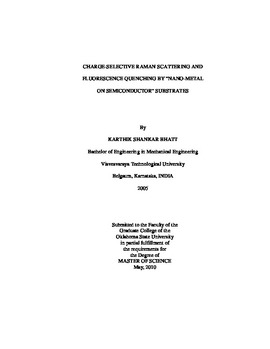| dc.contributor.advisor | Kalkan, Kaan | |
| dc.contributor.author | Bhatt, Karthik Shankar | |
| dc.date.accessioned | 2014-04-17T19:52:01Z | |
| dc.date.available | 2014-04-17T19:52:01Z | |
| dc.date.issued | 2010-05-01 | |
| dc.identifier.uri | https://hdl.handle.net/11244/9900 | |
| dc.description.abstract | An interesting attribute of monolayers of metal nanoparticles (NP) synthesized on semiconductor substrates is charging of NP induced by the Fermi level difference. This charging can be tapped in self-assembly, as well as selective adsorption of ions on NP, which augments the application of NP in surface plasmon resonance (SPR) sensors, surface-enhanced Raman scattering (SERS) substrates and other plasmonic devices. Although charging of NP is demonstrated in the literature by using surfactants, surfactant molecules cause signal interference. Further, surfactants form a physical barrier between analyte and metal, attenuating or completely eliminating surface-enhanced effects. In the present work, silver nanoparticles (AgNP) were synthesized on high conductivity Si wafers (p-Si and n-Si) employing the electroless reduction of AgNO3 by Si, as well as vapor deposition. Electric force microscopy (EFM) confirms the presence of NP charge and its expected variation (charge and magnitude) with the Fermi level difference. Using our charged, surfactant free nanoparticles, we demonstrate charge selective Raman scattering and fluorescence quenching for ionic fluorophores (fluorescein (-), rhodamine-6G (+) and acridine orange (+)). Furthermore, it is inferred from Atomic force microscopy (AFM), optical absorption and Mie scattering, that this charging phenomenon plays an important role in self-inhibiting growth and coalescence of Ag nanoparticles (AgNP) during chemical reduction. In particular, the positively charged AgNP do not coalesce despite a few nm interparticle spacing. Therefore, strong electromagnetic interactions between the particles develop, resulting in well resolved hybrid plasmon modes, probed by optical extinction. On the contrary, self-inhibition does not occur with negatively charged AgNP, resulting in the loss of surface plasmon resonance. | |
| dc.format | application/pdf | |
| dc.language | en_US | |
| dc.publisher | Oklahoma State University | |
| dc.rights | Copyright is held by the author who has granted the Oklahoma State University Library the non-exclusive right to share this material in its institutional repository. Contact Digital Library Services at lib-dls@okstate.edu or 405-744-9161 for the permission policy on the use, reproduction or distribution of this material. | |
| dc.title | Charge-Selective Raman Scattering and Fluorescence Quenching by "Nano-Metal on Semiconductor: Substrates" | |
| dc.type | text | |
| dc.contributor.committeeMember | Harimkar, Sandip P. | |
| dc.contributor.committeeMember | Zhang, Weili | |
| osu.filename | Bhatt_okstate_0664M_10736.pdf | |
| osu.college | Engineering, Architecture, and Technology | |
| osu.accesstype | Open Access | |
| dc.description.department | Mechanical & Aerospace Engineering | |
| dc.type.genre | Thesis | |
| dc.subject.keywords | charging | |
| dc.subject.keywords | electroless reduction | |
| dc.subject.keywords | fermi level difference | |
| dc.subject.keywords | sers | |
| dc.subject.keywords | silver nanoparticles | |
